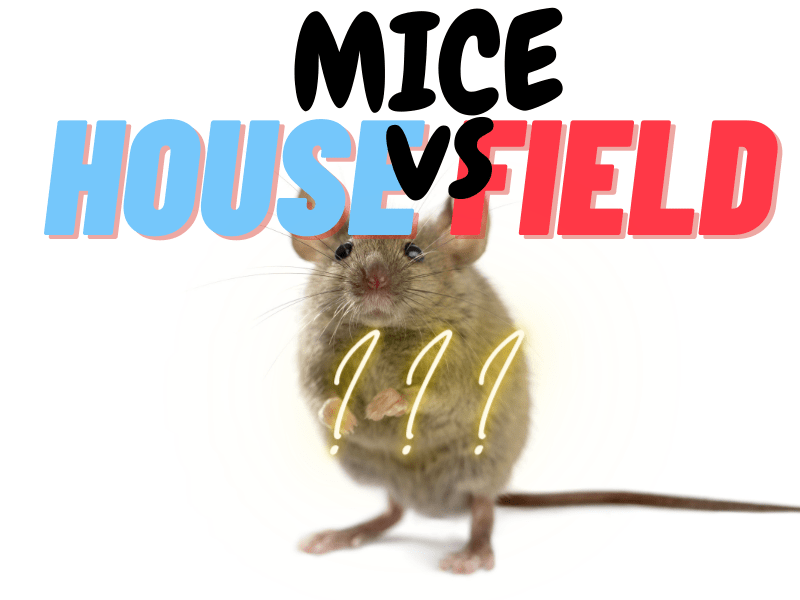As long as people have inhabited the earth, they’ve shared it with mice and other rodents. According to history, humans have encountered mouse infestations for at least 15,000 years.
These are the fuzzy little rodents that adore burrowing into your warm home for shelter and stolen grub. However, you may also encounter their close relative, the wood or field mouse. They have a lot of the same features but are different species. Think of them as the classic tale of the city mouse and the country mouse.
• Bodies
Many mouse species range from the tiniest African pygmy mice to those that are as large as rats. In general, mice are small, and their tails are often as long as their bodies. They are the contortionists of the rodent world because they’re able to squeeze their bodies through amazingly small crevices.
The standard house mouse is usually about 2-3 ½ inches long. Their rounded bodies can be shades of gray or brown with a white belly. They use their color as a natural camouflage, so their color often depends on the region they inhabit.
• Features
Their iconic features include large, rounded ears, beady black eyes, and a pointed nose with whiskers. They have five digits on each foot, and their hind legs are more extensive than their front ones. They communicate with a high-pitched squeak.
Conversely, field mice can grow up to four inches. They tend to have a reddish or beige coat with a white belly. Their eyes and ears are comparatively smaller than house mice, and they have larger and stronger hind legs. Also, field mice usually have white feet while house mice are a solid color.
Both of these pesky rodents have prominent incisors that they use to gnaw through wood and other materials to make nests and to crunch through tough seeds. While both species are avid runners and jumpers, the field mouse is quicker and can jump a little higher than house mice.
• Behaviors
All mice species, including house and field mice, are social animals. They thrive in the company of their kind and often nest together. Did you know that a group of mice is called a mischief? With all their destructive and thieving ways, it’s easy to understand the name.
As their name implies, field mice usually live-in forests and meadows away from human contact. However, house mice have become used to humans over thousands of years. They prefer to be squatters in homes and buildings that people occupy.
Field mice and house mice are both nocturnal species. They use the darkness as their natural camouflage to seek food to bring back to their nests to share with others. Unlike rats, mice don’t venture much farther than about 10 feet from their nest for food foraging.
• Preferred Environments
House mice are more tolerant of humans than their field mice cousins. If you have a mouse infestation, the chances are that it’s house mice. Field mice detest humans and stay as far away as they can. During winter cold and shortages of food, field mice are often forced to take shelter in a warm human abode.
Unlike many other social animals, mouse communities do not have a chain of command. Males of both species will often fight other males for dominance and mating privileges. They can often be territorial during breeding season.
These mice may be small, but they are quite intelligent. Studies have shown that mice have a good memory and can even be taught to do simple tasks. That may be good if you have a domesticated pet mouse, but it’s not a positive point when you’re dealing with a mouse infestation.
• Diet
Mice have small mouths and sharp incisors, which is perfect for eating grain, seeds, corn, and vegetation. Field mice are well-adapted to the woods and are fond of seeds, grass, and sometimes tree bark. However, they are omnivores and aren’t above eating insects, small invertebrates, or even gnawing on dead carcasses.
House mice have adapted to the more refined tastes of life. These critters have cohabited with people for so long that they’ve become accustomed to human food. Yes, they usually eat grains and seeds, but they will devour anything in your pantry. Bread, cereal, and anything sweet is very tempting for these rodents. If you also have a problem with roaches or crickets, these insects are some of the house mouse’s favorite appetizers.
• Life Cycles
Mice are mammals, so they have live births, and the mothers feed their young breastmilk. Tiny baby mice, called pups, are born hairless and blind and are entirely dependent on their mothers. House mice are prolific breeders and can have up to six pups to a litter. They also have multiple litters within the year, which can be up to 35 pups. Now, you understand how easy a mouse infestation can occur.
It’s a good thing that field mice prefer the outdoors because they multiply even faster. Females can birth up to 10 litters of pups each year, with up to 14 pups in a litter. Within a year, that can be up to 140 pups for just one female.
Both species have highly dependent pups who stay close to their mothers. The nursing mice will have fully developed ears by their fourth day and will have a full coat of hair by their 10th day. Within two weeks, the baby’s eyes are open. After their 21st day, they are weened and are considered adults ready to search for food and mates.
Getting Rid of House Mice and Field Mice
Your first line of defense against invading mice is to block possible entryways. Seal cracks and holes in your foundation and walls and repair or replace damaged screens. Keep trash cans, and dumpsters sealed and avoid leaving food scraps outside that can attract vermin. Make sure that hay, straw, or animal feed outside is stored correctly.
Seal up any suspected mouse holes in your walls, under sinks, or cabinet kickboards. Keep all pantry items in sealed containers like glass or heavy plastic. Clean up any spills immediately. Take out your trash often, and never leave dirty dishes sitting overnight. If you hear scratching and other activity in your walls, it’s a sure sign that mice have moved into your home.
You can always go the route of mouse traps, glue traps, or poison, but these can raise other safety issues for your family and pets. While cats are natural mouse predators, well-fed house cats often ignore mouse problems.
Final Thoughts
You are more likely to have a house mice invasion than field mice unless you live in the country. No matter which kind you have, a mouse infestation poses severe risks to your family and property. Professional extermination can get the unwanted pests out, and ensure your home is not at risk for the deadly viruses these rodents bring.








